
Related
We discuss the U.S. gun violence epidemic with historian Andrew McKevitt, who says, “We ought to conceive of our gun problem as a problem of gun capitalism.” He covers the history of the proliferation of individual gun ownership since World War II in his forthcoming book, Gun Country: Gun Capitalism, Culture & Control in Cold War America. McKevitt also discusses how the NRA and pro-gun lobby impedes progress on gun control through the implicit threat of “political violence.”
Transcript
AMY GOODMAN: It has been another deadly week in the United States as gun violence shattered families and communities across the country. In one of the most shocking cases, a white homeowner in Kansas City shot a Black teenager in the head who rang his doorbell by mistake. Prosecutors say 84-year-old Andrew Lester exchanged no words with 16-year-old Ralph Yarl before opening fire on him through a glass door, striking him in the chest and head. Yarl had simply gone to the wrong house to pick up his younger twin brothers. Yarl survived. He’s now recovering from a traumatic brain injury. The shooter’s grandson appeared on CNN Thursday and described his grandfather as a racist who avidly watched Fox News and embraced conspiracy theories.
Meanwhile, in New York, a 65-year-old man has been charged with second-degree murder for fatally shooting a 20-year-old woman named Kaylin Gillis, who had mistakenly pulled into the wrong driveway. In Elgin, Texas, two cheerleaders were shot by a man in a parking lot of a grocery store on Tuesday after one of them mistakenly tried to get into his car, thinking it was her own. Meanwhile, a North Carolina man has turned himself in after shooting a 6-year-old and her parents, after the girl tried to retrieve a basketball that had rolled into the man’s yard.
The number of mass shootings in the United States this year has now reached 166. On average, there’s been more than one mass shooting every day this year in the United States.
In Alabama, six people have been arrested on murder charges in connection with the recent mass shooting at a “Sweet 16” birthday party in Dadeville, Alabama, that left four people dead and 32 injured.
Over the weekend, the National Rifle Association held its annual convention in Indianapolis, Indiana, less than two hours from Louisville, Kentucky, where a gunman armed with an AR-15-style semiautomatic assault rifle killed five people at a bank where he used to work, April 10th.
To talk more about the gun epidemic in the United States, we’re joined now by Andrew McKevitt, associate professor of history at Louisiana Tech University, author of the forthcoming book Gun Country: Gun Capitalism, Culture & Control in Cold War America.
Drew, welcome to Democracy Now! It’s great to have you with us, though under horrible circumstances. Why don’t we start off where I just left off? And that is, as you have one mass shooting after another — right? — Louisville followed Nashville, where six people were killed, three of them 9-year-olds and three adults — the NRA holds its meeting. Republican presidential wannabes flock to that meeting. It is less than two hours from Louisville, where a mass shooting had just taken place. Can you put this all in context for us?
ANDREW McKEVITT: Sure, Amy. Well, thanks so much for having me. And I do wish this were not the kind of conversation we were having, but it does seem inevitable and perennial at this point.
I do think — I think — to put this in some context, I think we talk about our gun problem all wrong. I think the way we talk about it and the precise language we use to talk about these problems is the kind of language that the NRA and the gun lobby wants us to use. We often think about our gun problem in the language of rights and the law and the Second Amendment. We adopt the language of good guys with guns and bad guys with guns and the so-called law-abiding citizen. And when we do that, we’re using the very same language that they’ve crafted to understand these crises that we’re seeing more and more.
Instead, as I said at the beginning there, I think we ought to conceive of our gun problem as a problem of gun capitalism — that is, as a material problem. We are rapidly approaching the point at which we will be a country of a half-billion guns. That will happen before the end of this decade. And I don’t think it’s possible to conceive of solutions to our gun problems without that larger — without recognizing that larger materiality of guns in which we live, in which we are effectively swimming.
AMY GOODMAN: So, you’re talking about more guns than people in the United States. I want to go to this issue of the NRA, just a day after the five people were killed in a mass shooting in neighboring Kentucky. Indiana Senate Republicans honored NRA chief Wayne LaPierre ahead of the NRA’s annual convention in Indianapolis. Moms Demand Action responded in a report by WTHR 13.
CATHY WEINMANN: They have the audacity — the audacity — to stand on the floor of our Senate, in our state House, and honor the organization that far and away is most responsible for the proliferation of guns in our country. … It’s really a painful reminder that the Republican Party of the state of Indiana doesn’t care.
JENNIE RUNEVITCH: 13 News asked LaPierre directly about the criticism.
WAYNE LAPIERRE: We think all the federal gun laws ought to be enforced, and we could dramatically reduce crime in America.
AMY GOODMAN: That last voice, Wayne LaPierre. Well, at the NRA convention, Donald Trump gave the keynote address and called for firearms training for teachers.
DONALD TRUMP: I will also create a new tax credit to reimburse any teacher for the full cost of a concealed carry firearm and training from highly qualified experts. Who’s better? Who’s better? If even 5% of teachers, people that are skilled with arms — we want that — 5% were voluntarily armed and trained to stop active shooters, we would achieve effective deterrence, and the problem would cease to exist.
AMY GOODMAN: Your response to President Trump?
ANDREW McKEVITT: Yeah, well, I don’t know where the evidence for that claim comes from. We don’t have any — we don’t have any evidence that arming teachers in schools prevents mass shootings, will be a deterrent in any way, particularly for mass shooters who are often motivated, who see what they’re doing as a sort of endgame kind of action, that they intend their lives to end in those particular instances. And so, arming teachers is in no way going to be a deterrent.
But I think, more broadly, these comments speak to the extent to which guns are simply the material reality in which we live, particularly when it comes to things like handguns. This is a conversation we don’t often have so much, because we’re so often focused on these fearsome assault weapons, that have now become the target of even President Biden. But instead, thinking of this problem more in terms of the sort of mundane and commonplace relationship we have with firearms, such that it makes perfectly sense to many people in this country, in certain parts of this country, to suggest that teachers go to school armed, because those teachers already live in communities flooded with guns, and they don’t think — they don’t think it would violate any sort of moral or ethical norms for those teachers to go to school armed.
AMY GOODMAN: I mean, Drew McKevitt, I mean, look at — could you have a more gun-friendly state than Texas? And look what happened in Uvalde, as child —
ANDREW McKEVITT: Right.
AMY GOODMAN: — after child was gunned down, as SWAT teams, troopers, police, all of them — more than a hundred of them — waited for an hour. Talk about fully armed. We’re talking about military-level arming.
ANDREW McKEVITT: Right.
AMY GOODMAN: And they wouldn’t move forward. And yet you expect to have teachers?
ANDREW McKEVITT: Right, teachers with, essentially, no or little training, the equivalent of perhaps the kind of training you might get in a concealed carry class or self-defense class or something like that, not something like the kind of training you might expect police officers to go through — many police officers, too, who’ve also had sort of military training. So, the idea that we would arm teachers is simply absurd.
When I think about my campus, I don’t want anyone on my campus armed, including any of the teachers. And I don’t want myself armed. I think, beyond the very obvious mechanics of potential violence that that creates, there is also that notion of intimidation and the already — the power relationships that already exist between students and faculty and administrators. And introducing guns into that equation is just insane, to my thinking.
AMY GOODMAN: And, of course, what it does for those that are promoting it, it’s just buying more guns. Can you talk about the arming of Wayne — the honoring of Wayne LaPierre? This is the NRA, well known for its corruption, near bankruptcy. How does it possibly maintain the power over state and federal public officials, that do not represent — even the NRA membership is for levels of gun control. I mean, for example, in Colorado now, the Legislature just failed to pass an assault weapons ban, despite having a Democratic-controlled House, Senate and governor. Several House Democrats sided with Republicans to kill the bill in committee at 1 a.m. two nights ago.
ANDREW McKEVITT: Yeah. So, I think the NRA’s power comes from three places. One is the one to which we usually point, which is money. The NRA can dump hundreds of millions of dollars into elections, and obviously has been doing that for a long time now, though I think we tend to overestimate that a bit.
The other two ways in which the NRA can wield this kind of power are a little more subtle. One is the way in which they’re able to rally their base very quickly. They’ve been able to do this since the 1960s. They were one of the pioneers of direct mail campaigning and so forth, that was able to rally upwards of a million people already by 1968 to write their congresspeople, to lobby their local and state politicians to vote against potential federal and state legislation.
And the third way, which is the one we don’t talk about — and we don’t really want to talk about — is that the NRA really wields a lot of intimidation and power in that sense. There are, I am confident, politicians who will not cross the NRA, not because of the money issue and not because of the vote issue, but because they’re afraid of violence, but because they’re afraid of the kind of violence that — social violence and political violence, that the NRA could encourage if it wanted to.
AMY GOODMAN: You talk about the connection between guns and gun capitalism. What does capitalism have to do with it, Drew? That’s central to your forthcoming book.
ANDREW McKEVITT: Yeah, so, and again here, my argument is that I think we focus a little too much on questions of rights and abstract concepts like the interpretation of the Second Amendment, and not quite enough on just how much gun capitalism exploded, expanded, in the postwar era especially. This goes back to the end the Second World War. And in the 1950s and the 1960s, we see this incredible expansion of gun consumerism in the United States. In [inaudible] there was about 45 million —
AMY GOODMAN: We’re having a little trouble with the internet. A tree fell on Drew McKevitt’s house, so there are some problems there. But I wanted to go to Tennessee. As Tennessee is reeling, legislators pushed this week to pass laws that shield gun manufacturers instead of children. There is this 2005 law, the Protection of Lawful Commerce in Arms Act, that protected gun manufacturers. We’re going to go to break and then come back to Drew McKevitt. His forthcoming book is called Gun Country: Gun Capitalism, Culture & Control in Cold War America. Stay with us.
[break]
AMY GOODMAN: “All is Grace” by Palace Brothers. This is Democracy Now!, democracynow.org, The War and Peace Report. I’m Amy Goodman, as we continue our conversation with Drew McKevitt, author of the forthcoming book Gun Country: Gun Capitalism, Culture & Control in Cold War America. He’s associate professor of history at Louisiana Tech University. We’re talking to him in Shreveport. We only have a few more minutes, Drew, but if you — you got cut off right in the middle of you making that connection between this massive proliferation of guns in America — I mean, we don’t see anything like this in any industrialized country in the world — the connection between that and capitalism.
ANDREW McKEVITT: Yeah, that’s right. And bringing the world in is a really important component there, too, because it’s partly the world that helps arm Americans after World War II. We often think of how the United States is responsible for the proliferation of weapons and violence after the Second World War, which is of course all true throughout the Cold War, but more so arms come into the United States after the Second World War. And the American population is armed with the weapons that had been used in the Second World War and left over on battlefields in Europe and Asia. There’s a whole cohort of wily entrepreneurs, gun entrepreneurs, who maximize the profits they can get by grabbing these guns from Europe, sometimes for as cheap as less than a dollar each, bringing them over to the United States, and then selling them to an eager population, now increasingly, after the Second World War, with more leisure time, with more money, more income available for those kinds of activities. And, of course, the most famous of these war surplus imports — there were millions of them that come into the United States in the 1950s and the 1960s. The most famous of these is the Carcano rifle used by Lee Harvey Oswald to kill John F. Kennedy in 1963. But it’s just one of millions that come into the country and truly remake the consumer market for guns in the United States.
And they do that in two ways. One, they make it one centered around war, and firearms that have been involved in war and firearms that can be used for war. And that’s where we get — that’s where we see the trajectory leading to something like the popularity of the AR-15. And then, the other aspect is that it simply emphasizes cheapness. American consumerism drives down the price of these guns, and a $10 gun becomes just as accessible as a $150 gun. And that’s going to dramatically expand the gun market. As I said, the number of guns in the United States doubles every 25 years or so after the end of the Second World War, precisely because of that phenomenon.
AMY GOODMAN: And then you have the other way — it going the other way. I mean, you’ve got the gun violence in the United States and the U.S. involvement in international small arms trade, in trafficking, and refusing to sign off on, being an obstacle at the U.N. to sign off on treaties that would limit small guns in the world.
ANDREW McKEVITT: Yeah, that’s right. I mean, if we look back at the process in the United Nations beginning in the mid-1990s and leading all the way up to, finally, the signing of a completely watered-down treaty in 2013, we saw the real powerful influence of the NRA there, and in particular the NRA’s kind of bulldog, John Bolton, who went to the U.N. in 2001 and tried to shut down every international effort that would have created any kind of substantive controls on international small arms sales.
AMY GOODMAN: And then, very quickly, two issues — Tennessee. I mean, perhaps the trying to get rid of the two youngest Black lawmakers — the Republican House speaker and his allies in the Tennessee Legislature — was about trying to prevent the push for gun control in Tennessee, which so many support, though you wouldn’t know it within the Legislature. And now, while they’re not protecting the children, they want to protect the arms industry, a bill that’s now going to Bill Lee’s desk, the Tennessee governor, who signed off on a gun deregulation bill in a Beretta gun factory?
ANDREW McKEVITT: Yeah. So, you know, I had heard you mention the 2005 law, the Protection of Lawful Commerce in Arms Act, which already shields — which already shields gunmakers from liability in a number of ways. And that law was written in the wake of a wave of lawsuits against gunmakers by gun control organizations, by large municipalities, that sought to force the gunmakers to pay for the consequences of the seemingly uncontrolled proliferation of firearms that was dramatically — that had ticked up dramatically in the early 1990s. In addition to the very obvious human trauma, there are, of course, economic costs to gun violence, as well. And so, the PCLAA — or, the PLCAA, the intention of that was to shield gunmakers nationally. And, of course, it’s signed into law by the George W. Bush administration, so that gunmakers could not be sued for their guns working as they are designed: to maim and kill human beings.
What the Tennessee Legislature is doing, I think, is essentially a kind of lip service to — or, it’s essentially a moot point, in that there are already those protections in place. But I also think the Tennessee Legislature watched what happened last year in the Remington case, when Remington, the rifle maker Remington, settled with the Sandy Hook families for $73 million. And that’s what they’re trying to prevent, gun control organizations and activists from looking for loopholes in the 2005 law, like, for instance, in the case of Sandy Hook, targeting their advertising rather than the guns themselves. And Tennessee wants to cut that off, because, ultimately, the sanctity of gun capitalism must remain secure.
AMY GOODMAN: Drew McKevitt, I want to thank you so much for being with us, author of the forthcoming book Gun Country: Gun Capitalism, Culture & Control in Cold War America, speaking to us from Shreveport, where he’s an associate professor of history at Louisiana Tech University.

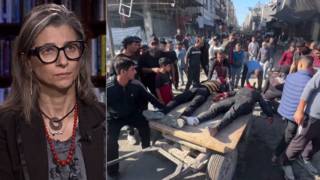
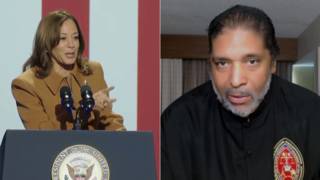
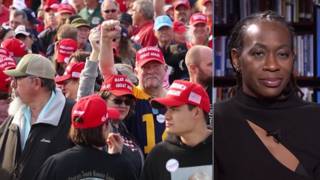
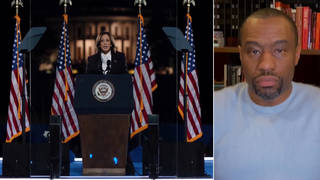



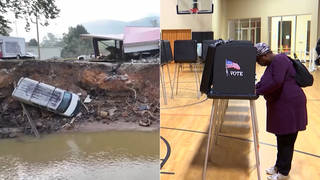

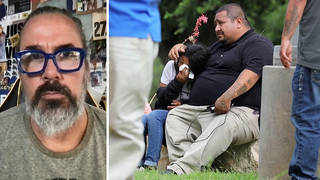

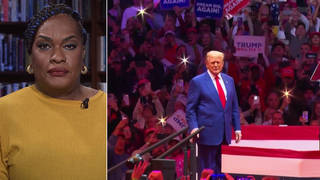
Media Options